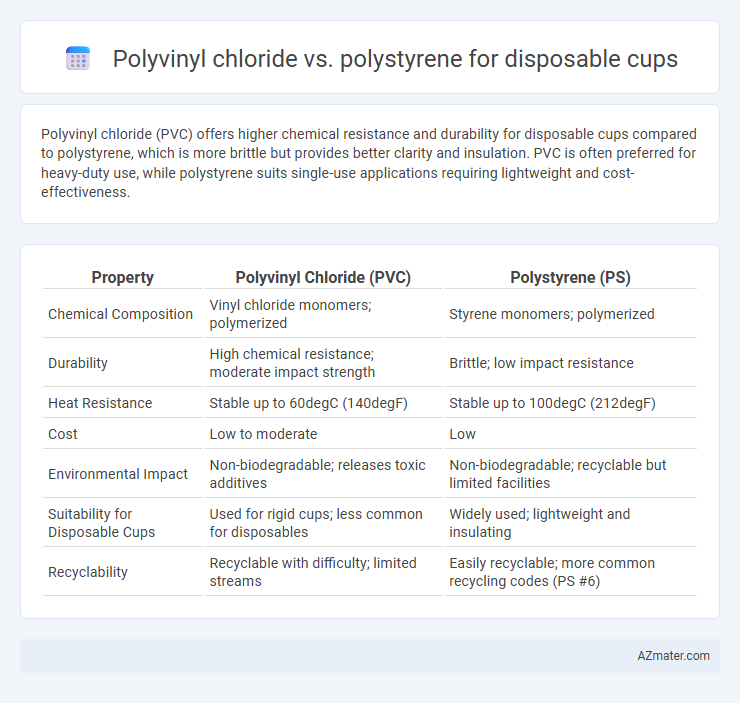Polyvinyl chloride (PVC) offers higher chemical resistance and durability for disposable cups compared to polystyrene, which is more brittle but provides better clarity and insulation. PVC is often preferred for heavy-duty use, while polystyrene suits single-use applications requiring lightweight and cost-effectiveness.
Table of Comparison
| Property | Polyvinyl Chloride (PVC) | Polystyrene (PS) |
|---|---|---|
| Chemical Composition | Vinyl chloride monomers; polymerized | Styrene monomers; polymerized |
| Durability | High chemical resistance; moderate impact strength | Brittle; low impact resistance |
| Heat Resistance | Stable up to 60degC (140degF) | Stable up to 100degC (212degF) |
| Cost | Low to moderate | Low |
| Environmental Impact | Non-biodegradable; releases toxic additives | Non-biodegradable; recyclable but limited facilities |
| Suitability for Disposable Cups | Used for rigid cups; less common for disposables | Widely used; lightweight and insulating |
| Recyclability | Recyclable with difficulty; limited streams | Easily recyclable; more common recycling codes (PS #6) |
Introduction to Disposable Cup Materials
Disposable cups commonly use materials like polyvinyl chloride (PVC) and polystyrene (PS) due to their versatility and cost-effectiveness. Polyvinyl chloride offers durability and resistance to chemicals, making it suitable for both hot and cold beverages, while polystyrene is favored for its lightweight nature and excellent insulation properties. Understanding the differences in thermal resistance, environmental impact, and recyclability of PVC and PS is crucial for selecting the ideal material for disposable cup manufacturing.
Overview of Polyvinyl Chloride (PVC) Properties
Polyvinyl Chloride (PVC) is a versatile thermoplastic polymer known for its excellent chemical resistance, durability, and flexibility, making it a reliable choice for disposable cup production. PVC offers superior impact resistance and can be easily processed into thin, lightweight sheets, providing cost efficiency and environmental resistance compared to other plastics. Its low permeability to gases and liquids ensures that beverages remain fresh, while its ability to withstand varying temperatures enhances its practical application in disposable cups.
Overview of Polystyrene (PS) Properties
Polystyrene (PS) is a lightweight, rigid thermoplastic polymer widely used in disposable cups for its excellent clarity and low cost. It offers high dimensional stability, good insulation properties, and resistance to moisture, making it suitable for both hot and cold beverages. Unlike polyvinyl chloride (PVC), polystyrene exhibits low chemical resistance and can become brittle under long-term exposure to heat and UV light.
Manufacturing Process Comparison
Polyvinyl chloride (PVC) disposable cups are commonly produced through injection molding and extrusion processes, offering high durability and chemical resistance. Polystyrene (PS) cups are typically manufactured using thermoforming, which allows for lightweight and rigid structures with excellent clarity. The manufacturing process for PS is faster and more cost-effective than PVC, but PVC provides better heat resistance and flexibility in design.
Cost Analysis: PVC vs Polystyrene Cups
Polyvinyl chloride (PVC) cups generally have a lower production cost compared to polystyrene cups due to cheaper raw materials and simpler manufacturing processes. Polystyrene cups, while slightly more expensive, offer benefits in rigidity and clarity that may justify the higher price in premium markets. Cost analysis reveals PVC cups dominate in budget-sensitive applications, whereas polystyrene cups are favored for their enhanced aesthetic and mechanical properties despite the increased cost.
Environmental Impact and Sustainability
Polyvinyl chloride (PVC) disposable cups pose significant environmental challenges due to toxic chemical leaching and difficult recycling processes, resulting in long-term pollution and hazardous waste. In contrast, polystyrene (PS) cups also contribute to environmental issues, such as non-biodegradability and high energy consumption in production, but certain expanded polystyrene types are lighter and use fewer raw materials. Both materials present sustainability concerns, with emerging alternatives emphasizing biodegradable or compostable cups to reduce ecological footprints and waste accumulation.
Health and Safety Considerations
Polyvinyl chloride (PVC) poses health risks due to its potential to release harmful chemicals such as phthalates and dioxins during manufacturing and disposal, raising concerns about toxicity and environmental impact. Polystyrene (PS), commonly used in disposable cups, can leach styrene, a possible carcinogen, especially when in contact with hot liquids, posing health risks to consumers. Safety evaluations favor alternatives like polypropylene or paper-based cups for reduced chemical exposure and improved environmental safety profiles.
Performance in Hot and Cold Beverage Applications
Polyvinyl chloride (PVC) offers superior chemical resistance and flexibility, making it ideal for hot beverage cups as it withstands high temperatures without deforming or releasing harmful substances. Polystyrene (PS), while rigid and providing excellent insulation for cold drinks, tends to become brittle and may release styrene compounds when exposed to hot liquids. Performance-wise, PVC cups excel in durability and thermal stability for hot beverages, whereas polystyrene cups are preferred for cold beverage applications due to their insulating properties and cost-effectiveness.
Market Trends and Consumer Preferences
Polyvinyl chloride (PVC) and polystyrene (PS) both dominate the disposable cup market, with PS preferred for its clarity and rigidity, catering to consumer demand for visually appealing beverage containers. Market trends indicate a growing shift toward polystyrene due to its cost-effectiveness and recyclability, aligning with increased environmental awareness among consumers. However, regulatory pressures on PVC, stemming from concerns about chemical safety and sustainability, are reducing its market share in disposable cup applications.
Conclusion: Choosing the Right Material for Disposable Cups
Polyvinyl chloride (PVC) offers durability and chemical resistance, making it suitable for cold and some hot beverages, but its environmental impact and potential health concerns limit its appeal. Polystyrene (PS) provides excellent insulation and lightweight properties, ideal for hot drinks, though it poses challenges in biodegradability and recyclability. Selecting the right material depends on balancing performance needs with environmental sustainability and regulatory compliance in disposable cup production.

Infographic: Polyvinyl chloride vs Polystyrene for Disposable Cup
 azmater.com
azmater.com